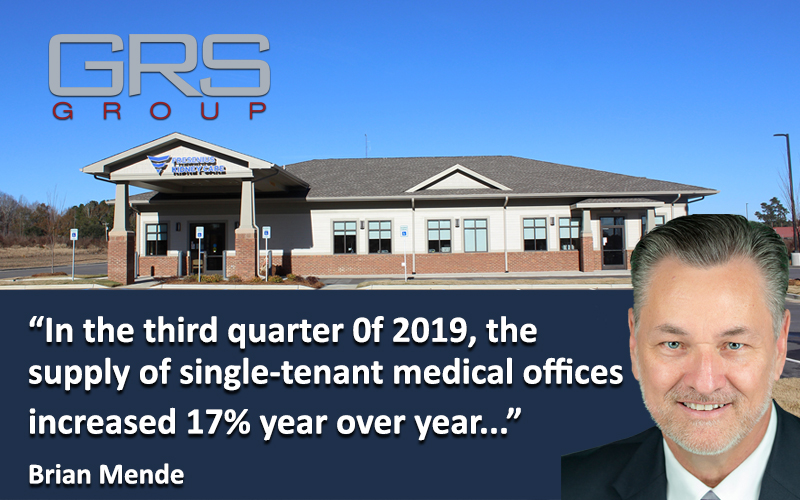Brian Mende, CPG is a vice president at GRS Group. He can be reached at 845.786.9092 or via email at [email protected].
Investors interested in single-tenant real estate that want to have as much e-commerce immunity as possible could do worse than exploring the medical sector of net lease arena.
Though telemedicine has become increasingly popular, patients still need several procedures done in-person at medical facilities. And medical uses have become common alternative tenants in shopping centers.
As a result of these developments and others, there is strong demand for these assets, and capitalization rates already low, dropped slightly during the third quarter, according to The Boulder Group.
Medical-use cap rates came in at 6.45 percent during the period, a drop from 6.47 percent during 2018’s third quarter. Net lease cap rates across all tenant uses were dropped to 6.35 percent from 6.38 percent. The reason for the difference, says Boulder, is that the medical sector does not have as many investment-grade tenants as others, such as drug stores.
Private investors are interested in putting money toward credit-backed tenants.
One of those is Fresenius Medical Care, which operates about 2,585 dialysis centers in North America at the end of its third quarter, a four-percent increase from the same year-ago period.
Dialysis facilities enjoyed the lowest cap rates, at 6.15 percent, though that was an increase from six percent during last year’s third quarter, possibly due to more supply coming on the market. In the third quarter, the supply of single-tenant medical offices increased 17 percent year over year, Boulder says.
The other tenants favored by private investors are associated with hospital-backed medical groups. Urgent care facilities, which often fall under this category, saw Q3 cap rates fall to 7.25 percent from 7.3 percent. However, of all tenants in the sector, only about 27 percent are investment grade.
That’s where institutional investors come in. They are more liable to acquire assets leased by physician groups, which trade for higher cap rates. General doctor-leased asset cap rates fell during the third quarter year over year, though, to 6.75 percent from 6.81 percent.
When comparing investment grade with non-investment grade transactions, the average sale of the former came in at just over $3.1 million, or $374 per square foot. Non-investment averaged $2.4 million, or $346 per square foot.
In Boulder’s report, the biggest Q3 asset sale was in Wichita, Kan., where an Integrated Health Systems property sold for $8.1 million, or $244 per square foot, at a 6.1 percent cap rate. The second-largest trade was a SimonMed Imaging asset, that transacted for just under $6 million, $685 per square foot and a 6.31 percent cap rate.
With investors looking for real estate that is Internet immune, and an aging population, the appetite for medical net lease shouldn’t die down any time soon.
About GRS Group
On the leading edge of innovation in commercial real estate transactions, Global Realty Services Group provides its clients with unsurpassed expertise in the areas of Transaction Services, Title Insurance and Sustainability Solutions. With offices across the United States, Europe, and affiliates around the globe, GRS Group provides local market knowledge with a global perspective for institutional real estate investors, occupiers and lenders worldwide. The GRS Group team has evaluated and advised on over $1 trillion in CRE transactions.

